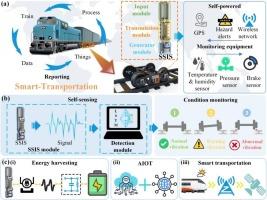Self-powered and self-sensing intelligent suspension for application in heavy-haul trains
IF 7
2区 工程技术
Q1 ENERGY & FUELS
Sustainable Energy Technologies and Assessments
Pub Date : 2025-09-25
DOI:10.1016/j.seta.2025.104600
引用次数: 0
Abstract
Energy issues have long been a key focus worldwide, particularly in the transportation sector, where energy consumption is substantial. This paper proposes a self-powered and self-sensing intelligent suspension (SSIS) based on energy harvesting, which captures low vibrational frequency and amplitude to address the power supply issue of heavy-haul train carriages and enable an onboard train condition monitoring system. The SSIS consists of three modules: a suspension vibration input module, a transmission module, and a generator module, and it generates electrical energy through an electromagnetic generator (EMG). The system was developed in MATLAB to study the mechanical characteristics and energy harvesting performance. Additionally, Simpack software was used to establish a coupled dynamics model of the vehicle-track-suspension system, allowing for the study of vibration and energy harvesting characteristics. Moreover, laboratory and field tests confirm that SSIS can effectively provide continuous power to LED lights and sensors. In field tests, the proposed system achieved a maximum voltage of 23.4 V, charging three parallel 10,000 μF capacitors within 45 s, then maintaining an output voltage above 3 V. Furthermore, the paper introduces the Long Short-Term Memory (LSTM) deep learning to enable intelligent monitoring of train operational conditions by analyzing and classifying the EMG voltage signal, with an accuracy rate of 95.06 %. Therefore, this paper presents an innovative and practical power supply solution, featuring a power density of 4,192.84 W/m3 and intelligent monitoring in heavy-haul trains, with considerable potential for future applications.

用于重载列车的自供电自感知智能悬架
能源问题长期以来一直是全世界关注的焦点,特别是在能源消耗很大的运输部门。本文提出了一种基于能量收集的自供电自感知智能悬架(SSIS),该悬架能够捕获低振动频率和振幅,以解决重载列车车厢的供电问题,并实现车载列车状态监测系统。SSIS由悬架振动输入模块、传输模块和发电机模块三个模块组成,通过电磁发电机(EMG)产生电能。在MATLAB中开发了该系统,研究了该系统的力学特性和能量收集性能。此外,利用Simpack软件建立了车辆-轨道-悬架系统的耦合动力学模型,研究了车辆-轨道-悬架系统的振动和能量收集特性。此外,实验室和现场测试证实,SSIS可以有效地为LED灯和传感器提供连续电源。在现场测试中,该系统实现了23.4 V的最大电压,在45 s内对3个10000 μF并联电容器充电,并保持输出电压在3v以上。此外,本文还引入了长短期记忆(LSTM)深度学习,通过对肌电电压信号的分析和分类,实现对列车运行状况的智能监控,准确率达到95.06%。因此,本文提出了一种创新实用的电源解决方案,其功率密度为4,192.84 W/m3,可用于重载列车的智能监控,具有相当大的未来应用潜力。
本文章由计算机程序翻译,如有差异,请以英文原文为准。
求助全文
约1分钟内获得全文
求助全文
来源期刊

Sustainable Energy Technologies and Assessments
Energy-Renewable Energy, Sustainability and the Environment
CiteScore
12.70
自引率
12.50%
发文量
1091
期刊介绍:
Encouraging a transition to a sustainable energy future is imperative for our world. Technologies that enable this shift in various sectors like transportation, heating, and power systems are of utmost importance. Sustainable Energy Technologies and Assessments welcomes papers focusing on a range of aspects and levels of technological advancements in energy generation and utilization. The aim is to reduce the negative environmental impact associated with energy production and consumption, spanning from laboratory experiments to real-world applications in the commercial sector.
 求助内容:
求助内容: 应助结果提醒方式:
应助结果提醒方式:


